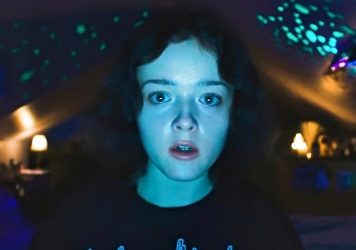
Jane Schoenbrun's sophomore feature is an unnerving take on loneliness, isolation, and the enduring mysteries of children's media.
The first shot of I Saw The TV Glow is quite the opening salvo. The camera creeps along a suburban street just after dusk, passing over tangled veiny chalk art, the world covered in a blue so deep it seems to spill off the screen. The image precedes a film no less vibrant or eerie; its brash, attractive color palette pulls you under, and only when you’re fully submerged does it start to feel like you’re drowning. Director Jane Schoenbrun, whose debut film We’re All Going to the World’s Fair was shot almost entirely through webcams, announces themself as a vital new cinematic talent.
In their sophomore film, Schoenbrun focuses on two outcast teens, sheltered Owen and antisocial Maddy, who bond over The Pink Opaque, a Buffy and The Secret World of Alex Mack-inspired fantasy television series. On The Pink Opaque, the two spunky leads use their telepathic connection to fight surprisingly gruesome monsters – a dynamic which unsettles and entrances the pair. What we see of The Pink Opaque is remarkably compelling for a 90s children’s show, and Schoenbrun takes pains to avoid judgmentally depicting it as cheesy or inept, making it easy to see why our leads become so fixated on its mysteries.
“Sometimes The Pink Opaque feels more real than real life, you know?” says Maddy, who patterns her queer presentation after one of the show’s protagonists. The show becomes a neutral space where the two can grow close to one another while stifling the uncomfortable, painful facts of their suburban lives. I Saw The TV Glow spends most of its first half in a daze of nostalgia for the queer 90s, affectionate towards the period in a way that’s never saccharine.
As the film goes on, though, its disparate horror elements coalesce into a gut-wrenching portrait of anxiety and repression. Surreal agents of terror surround Owen: Fred Durst is terrifying in his brief appearances as Owen’s father, his stony silence and fleshy face recalling a Lon Chaney monster, while cult comedian Conner O’Malley channels his off-putting brand of humour into the familiar malevolent energy of a bullying coworker. The world around Owen seems increasingly hostile, and the film’s bright, deep colors begin to feel like they’re taunting him. Even scenes from The Pink Opaque go from a kid-friendly Are You Afraid of the Dark? style of horror to something genuinely nightmare-inducing. I Saw The TV Glow creeps up on you, holding your focus so intently you hardly notice when it begins to fray at the margins.
To discuss the film’s relationship to themes of transgender identity would be to delve too deeply into spoilers; I Saw The TV Glow is a film best experienced knowing as little as possible beforehand, and it is uniquely structured such that its plot only really begins at the halfway mark. But its bombastic depiction of the emotional distress which can accompany transgender life is among the most potent in cinema – perhaps the most so since a film it recalls quite a bit: Robert Hiltzik’s 1983 slasher Sleepaway Camp. It’s rare that a film attempting to tell a trans story – whether on purpose or accidentally – has any success. I Saw The TV Glow reaches even higher, and assuredly hits its mark.
Published 24 Jan 2024

A teenage girl gets caught up in a mysterious online game in Jane Schoenbrun's fascinating tech-horror debut.

The We’re All Going to the World’s Fair director reflects on the importance of allowing trans filmmakers to tell their own stories.

New year, new movies! We look ahead to the films coming our way in 2024 – including new projects from Bong Joon-ho, George Miller, Rose Glass and many more.